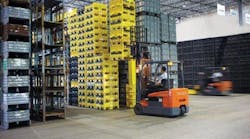Safety has always been a top priority for distribution and manufacturing companies, but improvements can always be implemented. As June is National Safety Orbis offers some times on how to evaluate the safety of supply chains.
Tip 1: Decrease risk with innovative materials
It’s difficult to predict what a unit load will interact with throughout the supply chain, so pallet material advancements are helping operators protect against any potential risks. Reusable plastic pallets, blended with fire-retardant, metal and X-ray-detectable additives are just some of the new materials that have been developed to minimize risk.
- Fire-retardant pallets: Many fire-retardant plastic materials are compliant with the Food and Drug Administration. This material enables fire-retardant pallets, which are approved by Factory Mutual Research Corporation and meet fire rating requirements equivalent to wood pallets to be used in food processing plants.
- Metal and X-ray detectable: Available in select pallets, metal-detectable additives are blended into the plastic, allowing foreign objects to be detected before making their way into finished goods. This is a feature wood pallets cannot offer. Similar to metal-detectable additives, products with X-ray detectable material use barium sulfate as a means of detection.
Tip 2: Assist employees with innovative ergonomics
Between the evolving workforce and skyrocketing workers’ compensation and health care costs, ergonomically designed containers simultaneously are needed to improve worker safety for the aging workforce and the bottom line.
The characteristics of reusable packaging, including the consistent size and unique features — such as access doors that make it easy for employees to reach the bottom of containers, collapsible container walls and wheeled solutions — can result in fewer strains and musculoskeletal disorders. This could result in fewer reported incidents related to packaging because of improved stackability, easier handling, and better material tracking and locating.
Tip 3: Keep workers healthy with less debris, mold and dust
Reusable plastic packaging offers cleanliness benefits that prevent employee contact with debris, mold and dust. The hygienic design allows for proper cleaning and allergen management. Hygienic plastic pallets, for example, have a nonporous structure so they cannot absorb moisture, odor or mold and don’t have cavities or hollow areas for water to collect.
These traits are not only important for customer purposes but also for the safety of employees, particularly those with allergies. An estimated 15 million Americans have food allergies, and every year, allergens cost businesses $25 million as they are sued, fined or shut down due to contact with allergic customers or employees. To help combat this, reusable packaging cleanly moves and stores food products, supporting safe and sanitary conditions.
Tip 4: Reduce sharp and loose object exposure with durable packaging
The smooth design of reusable plastic packaging makes it free from protruding nails, loose boards and staples that are common with alternative pallets, reducing the risk of employee exposure to sharp or loose objects. The texture of plastic packaging helps reduce risks often associated with wood pallets, including cuts and splinters, and promotes safer stacking. Similarly, plastic packaging doesn’t break easily — preventing any broken and often unsafe wood pieces from falling on a plant floor.



